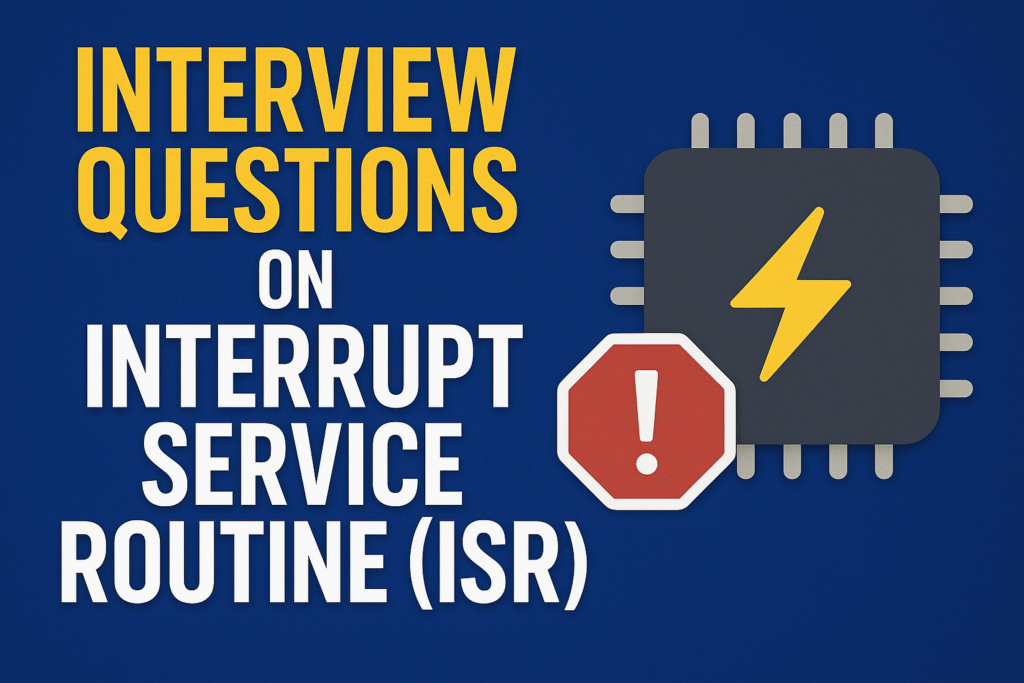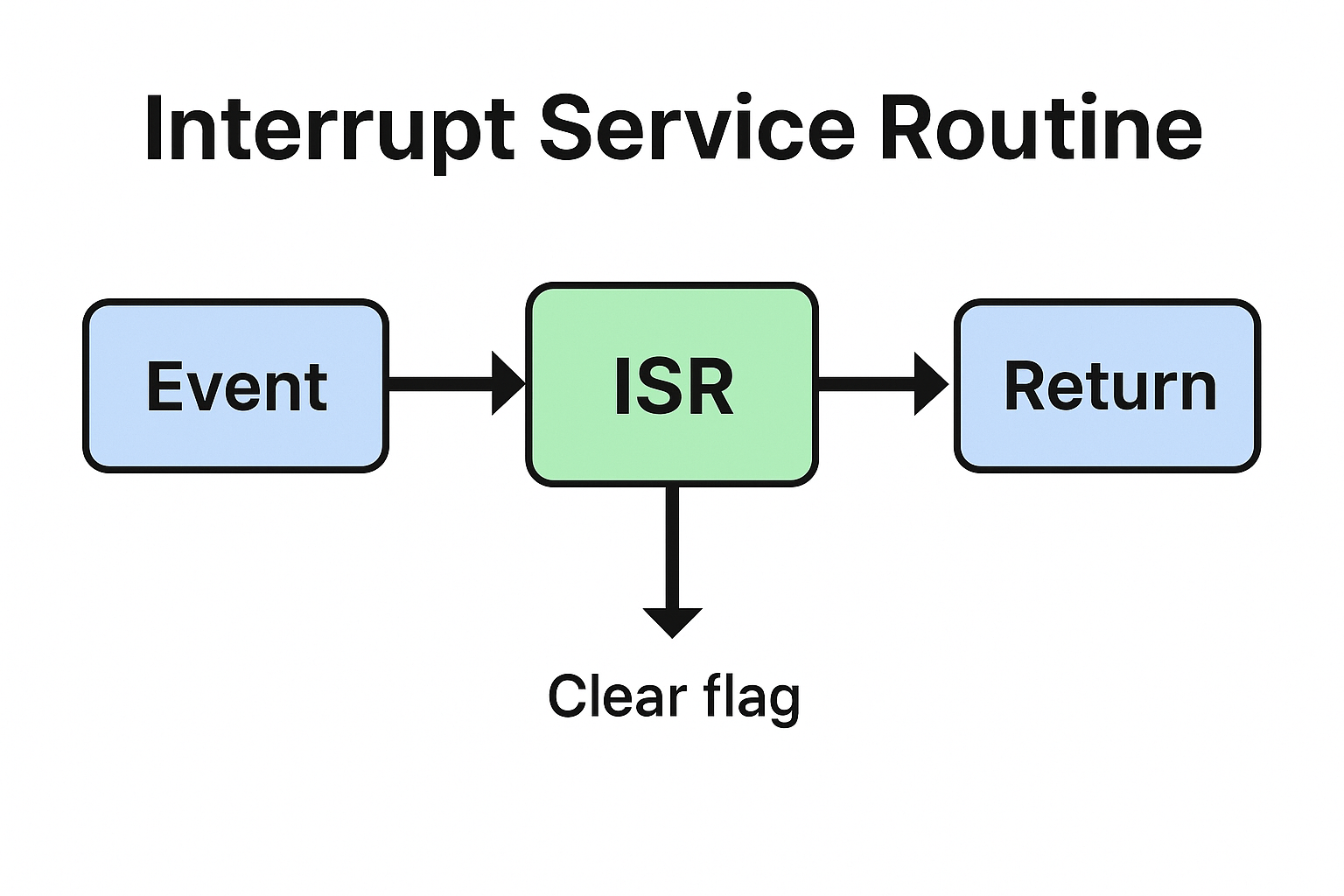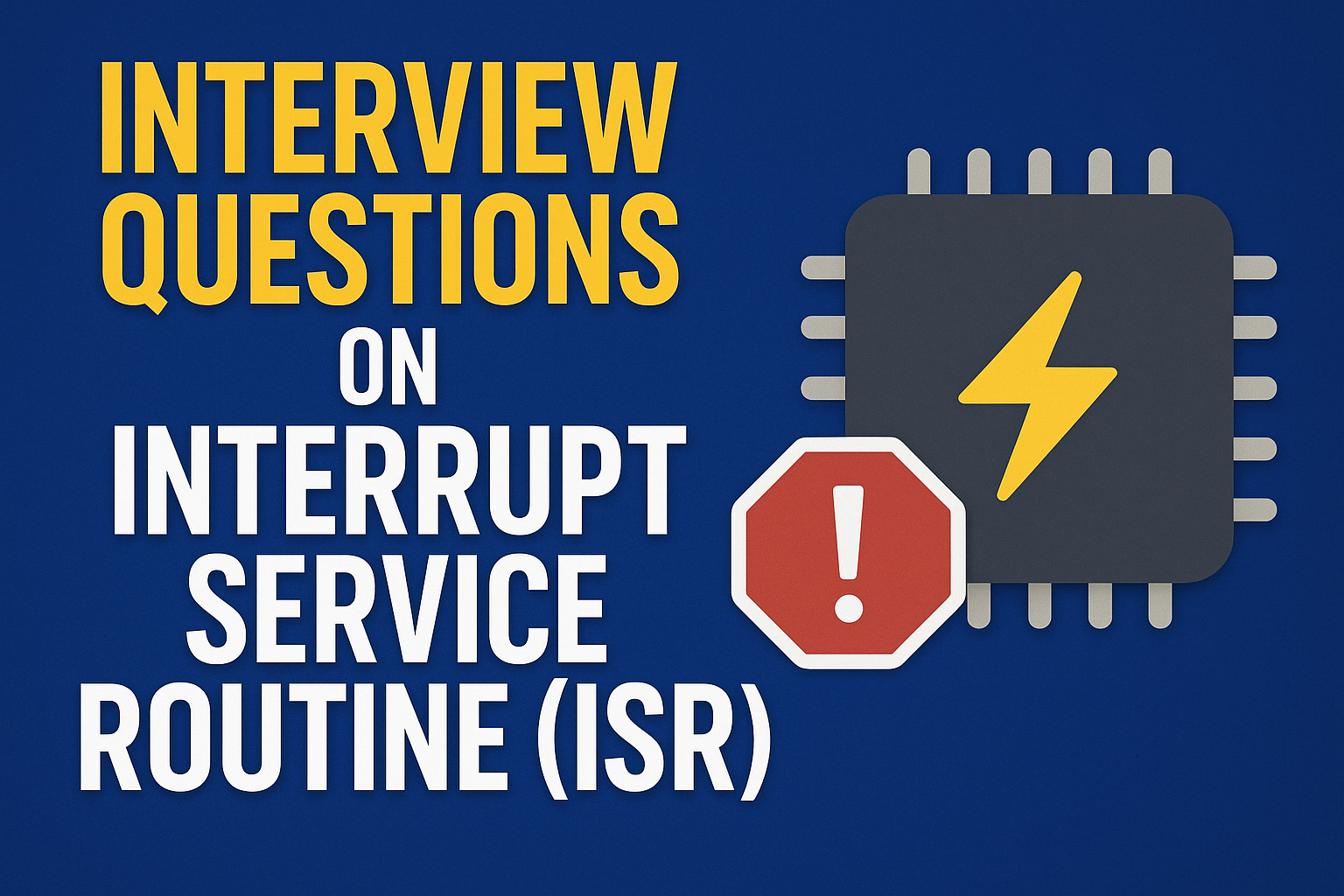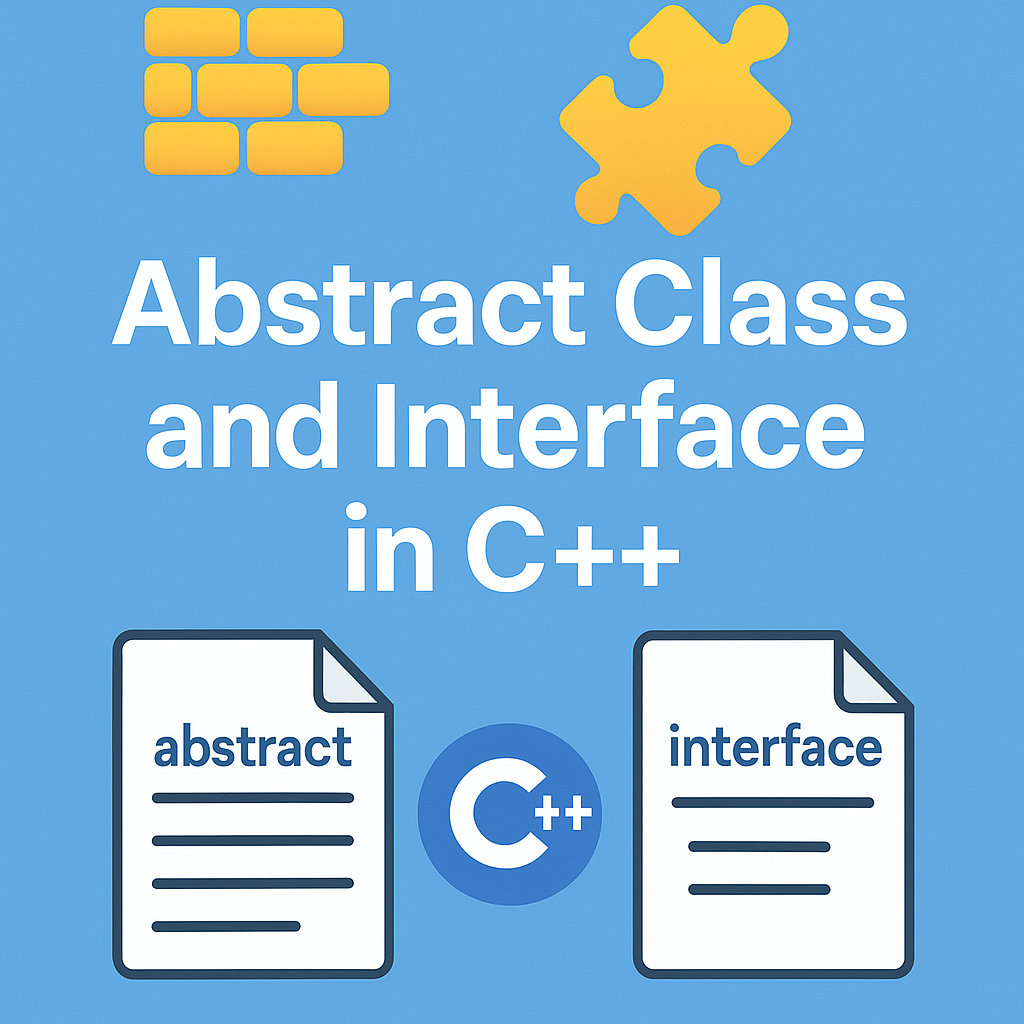Interview Questions on Interrupt Service Routine : When preparing for embedded systems interviews, one of the most important topics is the Interrupt Service Routine (ISR). Recruiters often ask questions on ISR because it is a core concept in microcontrollers, operating systems, and real-time systems. In this guide, we’ll go through commonly asked ISR interview questions, explained in a simple way for beginners.
What is an Interrupt Service Routine (ISR)?
An Interrupt Service Routine (ISR) is a special block of code that executes when a hardware or software interrupt occurs. Instead of continuously checking a condition (polling), the system pauses its normal execution and jumps to the ISR to handle the event immediately.
Example: When you press a button on a microcontroller, an interrupt occurs, and the ISR handles the button press.

Common Interview Questions on Interrupt Service Routine (ISR)
1. What is an ISR in embedded systems?
Answer: An ISR is a function that handles interrupts. It is triggered automatically when an interrupt occurs, allowing the CPU to respond quickly to external or internal events.
2. What are the characteristics of an ISR?
Answer:
- Fast execution – Should be short and efficient.
- No return values – ISR does not return values.
- No blocking calls – Avoid using functions like
delay()inside ISR. - Context saving – CPU saves the current state before jumping to ISR.
3. Can an ISR call another function?
Answer: Yes, but it should only call lightweight functions. Heavy operations inside ISR may slow down the system and block other interrupts.
4. What are nested interrupts?
Answer: Nested interrupts occur when a higher-priority interrupt occurs while another ISR is still running. In such cases, the CPU pauses the current ISR and executes the higher-priority one.
5. Why should we keep ISRs short?
Answer: Long ISRs delay the processing of other interrupts. In real-time systems, this can cause missed events and system instability.
6. What is the difference between ISR and a normal function?
Answer:
- ISR executes automatically when an interrupt occurs, while a normal function is called manually.
- ISR does not return values, while functions can.
- ISR runs in a special CPU context and must be as short as possible.
7. Can we use global variables inside ISR?
Answer: Yes, but they must be declared as volatile so that the compiler does not optimize them. This ensures real-time updates between the ISR and the main program.
8. What is interrupt latency?
Answer: Interrupt latency is the time delay between an interrupt request and the start of ISR execution. Low latency is important for real-time systems.
9. How do you handle multiple interrupts?
Answer:
- Assign priority levels to interrupts.
- Use interrupt vectors to map different ISRs.
- Ensure critical ISRs are shorter and higher priority.
10. What are some best practices for writing ISRs?
Answer:
- Keep ISRs short and simple.
- Use global variables carefully (mark them as volatile).
- Avoid using printf, malloc, or delay inside ISR.
- Handle only critical tasks inside ISR and defer others to the main loop or task scheduler.
List of Interview Questions on Interrupt Service Routine (ISR)
Basic Questions of Interrupt Service Routine interview questions
- What is an Interrupt Service Routine (ISR)?
- Why do we need ISR in embedded systems?
- What are the main features of an ISR?
- What is the difference between polling and ISR?
- What happens when an interrupt occurs?
Intermediate Questions of ISR in embedded systems
- What are the rules for writing an ISR?
- Why should an ISR be short and fast?
- Can we use global variables inside ISR?
- What is the role of the
volatilekeyword in ISR? - What is interrupt latency?
- Can an ISR return a value? Why or why not?
- What is the difference between ISR and a normal function?
- Can ISRs be nested? What are nested interrupts?
- How does the CPU know which ISR to execute?
- What is an interrupt vector table?
Advanced Questions of common ISR interview questions
- How are multiple interrupts handled in a system?
- What are interrupt priorities?
- What is the difference between maskable and non-maskable interrupts?
- What are reentrant and non-reentrant ISRs?
- Can we use dynamic memory allocation (malloc/free) inside ISR?
- Why is it not recommended to use printf() inside ISR?
- What are some common mistakes while writing ISRs?
- How do you handle critical tasks inside ISR?
- What happens if an ISR takes too long to execute?
- How do modern microcontrollers reduce interrupt latency?
Practical/Implementation Questions of interrupt handling in embedded systems
- How do you declare an ISR in C/C++?
- How do you enable and disable interrupts in a microcontroller?
- What is the difference between hardware and software interrupts?
- Can an ISR call another ISR?
- How do you share data between ISR and the main program?
- What are best practices for writing ISRs?
- What tools or debuggers can be used to test ISR execution?
- Can an ISR cause a system crash? How?
- How does an operating system handle interrupts differently from bare-metal programming?
- What is the difference between vectored and non-vectored interrupts?
1.What is an Interrupt Service Routine (ISR)?
Ans: An ISR is a special function that executes automatically when an interrupt occurs, allowing the CPU to handle events quickly without polling.
2.Why do we use ISR in embedded systems?
Ans: ISR reduces CPU load, improves response time, and makes systems more efficient by handling events only when they occur.
3. Can an ISR return a value?
Ans: No, ISRs cannot return values because they are executed by hardware/OS, not called like regular functions.
4. Why should ISR be short and fast?
Ans: Long ISRs block other interrupts and can cause system delays or missed events.
5. Can we use global variables in ISR?
Ans: Yes, but they should be declared as volatile to ensure real-time updates between ISR and the main program.
6. What is interrupt latency?
Ans: Interrupt latency is the time delay between an interrupt request and the start of ISR execution.
7. Can we use printf or delay inside ISR?
Ans: No, functions like printf, malloc, or delay should be avoided inside ISR as they are slow and may cause system instability.
8. What is the difference between ISR and normal function?
Ans:
a) ISR executes automatically when an interrupt occurs, while a normal function is called explicitly.
b) ISR does not return values, while functions can.
c) ISR runs in a special CPU context.
9. What are nested interrupts?
Ans: Nested interrupts occur when a higher-priority interrupt interrupts the execution of a lower-priority ISR.
10. What are best practices for writing ISRs?
Ans:
a) Keep ISRs short and efficient.
b) Use volatile for shared variables.
c) Avoid blocking functions.
d) Handle only critical tasks inside ISR, defer the rest to main loop or task scheduler.
You can also Visit other tutorials of Embedded Prep
- Multithreading in C++
- Multithreading Interview Questions
- Multithreading in Operating System
- Multithreading in Java
- POSIX Threads pthread Beginner’s Guide in C/C++
- Speed Up Code using Multithreading
- Limitations of Multithreading
- Common Issues in Multithreading
- Multithreading Program with One Thread for Addition and One for Multiplication
- Advantage of Multithreading
- Disadvantages of Multithreading
- Applications of Multithreading: How Multithreading Makes Modern Software Faster and Smarter”
- Master CAN Bus Interview Questions 2025
- What Does CAN Stand For in CAN Bus?
- CAN Bus Message Filtering Explained
- CAN Bus Communication Between Nodes With Different Bit Rates
- How Does CAN Bus Handle Message Collisions
- Message Priority Using Identifiers in CAN Protocol

Mr. Raj Kumar is a highly experienced Technical Content Engineer with 7 years of dedicated expertise in the intricate field of embedded systems. At Embedded Prep, Raj is at the forefront of creating and curating high-quality technical content designed to educate and empower aspiring and seasoned professionals in the embedded domain.
Throughout his career, Raj has honed a unique skill set that bridges the gap between deep technical understanding and effective communication. His work encompasses a wide range of educational materials, including in-depth tutorials, practical guides, course modules, and insightful articles focused on embedded hardware and software solutions. He possesses a strong grasp of embedded architectures, microcontrollers, real-time operating systems (RTOS), firmware development, and various communication protocols relevant to the embedded industry.
Raj is adept at collaborating closely with subject matter experts, engineers, and instructional designers to ensure the accuracy, completeness, and pedagogical effectiveness of the content. His meticulous attention to detail and commitment to clarity are instrumental in transforming complex embedded concepts into easily digestible and engaging learning experiences. At Embedded Prep, he plays a crucial role in building a robust knowledge base that helps learners master the complexities of embedded technologies.




Leave a Reply to Francesco Beer Cancel reply